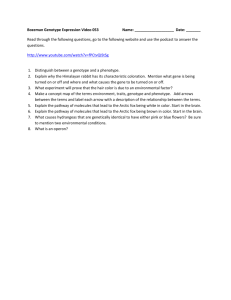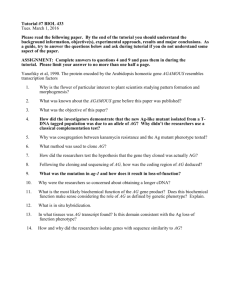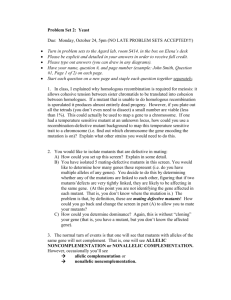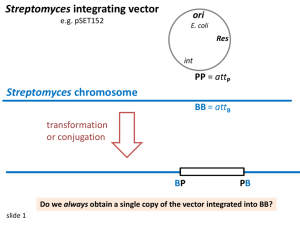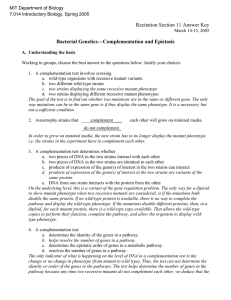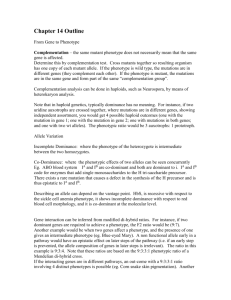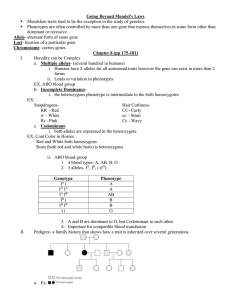Recitation Section 11 Bacterial Genetics—Complementation and Epistasis
advertisement
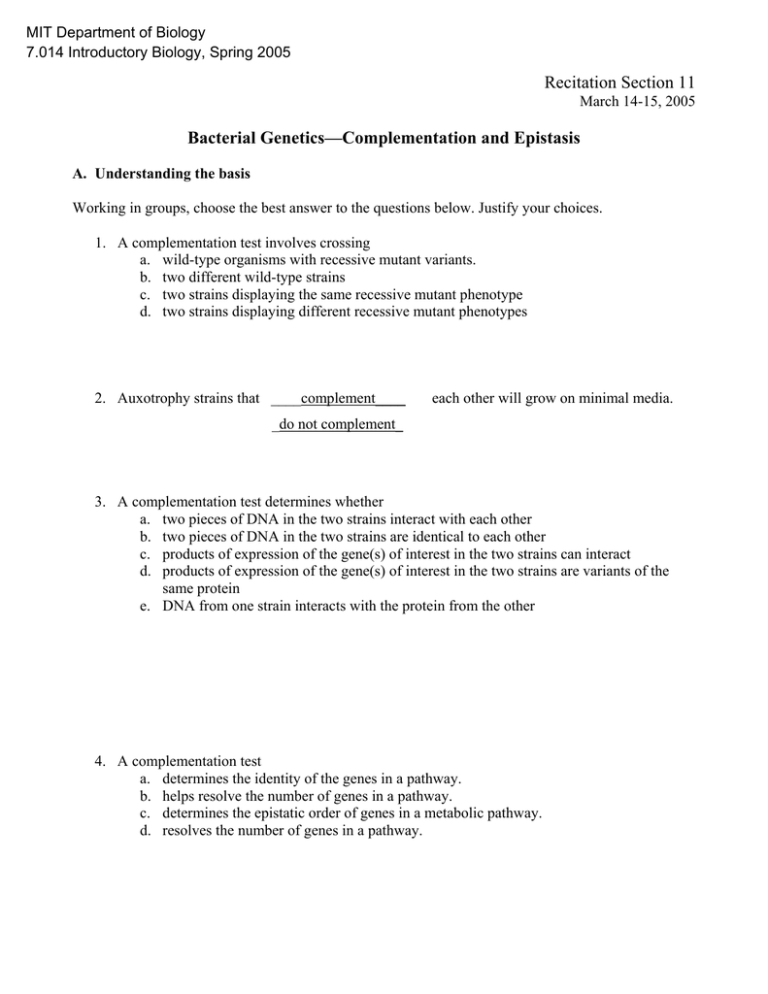
MIT Department of Biology 7.014 Introductory Biology, Spring 2005 Recitation Section 11 March 14-15, 2005 Bacterial Genetics—Complementation and Epistasis A. Understanding the basis Working in groups, choose the best answer to the questions below. Justify your choices. 1. A complementation test involves crossing a. wild-type organisms with recessive mutant variants. b. two different wild-type strains c. two strains displaying the same recessive mutant phenotype d. two strains displaying different recessive mutant phenotypes 2. Auxotrophy strains that ____complement____ each other will grow on minimal media. _do not complement_ 3. A complementation test determines whether a. two pieces of DNA in the two strains interact with each other b. two pieces of DNA in the two strains are identical to each other c. products of expression of the gene(s) of interest in the two strains can interact d. products of expression of the gene(s) of interest in the two strains are variants of the same protein e. DNA from one strain interacts with the protein from the other 4. A complementation test a. determines the identity of the genes in a pathway. b. helps resolve the number of genes in a pathway. c. determines the epistatic order of genes in a metabolic pathway. d. resolves the number of genes in a pathway. 5. All organisms in the same complementation group have identical DNA sequence. T F 6. All organisms in the same complementation group have identical protein content and structure. T F 7. If gene A is epistatic to gene B then the AB double mutant has the a. phenotype conferred by the allele of gene A. b. phenotype conferred by the allele of gene B. c. wild-type phenotype. d. mutant phenotype at all times. B. Complementation I. Example 1—Phe pathway Consider the following hypothetical pathway for the synthesis of the amino acid phenylalanine. • compound 1 is converted to compound 2 by enzyme A encoded by the pheA gene • compound 2 is converted to phenylalanine by enzyme B encoded by the pheB gene 1 ⎯⎯A⎯ ⎯→ 2 ⎯⎯B⎯→ phenylalanine You also have mutants, p1 through p5. These mutants cannot synthesize phenylalanine and thus cannot grow without addition of phenylalanine. • p1, p2, and p4 are in gene pheA • p3 and 5 are in pgene pheB 1. Suppose that you construct a diploid strain which contains both mutations, p1 and p2. Assuming that the phenotype associated with each of these mutations is recessive to wild type (one good copy of a gene is sufficient for wild-type phenotype), predict the phenotype of this diploid? 2. Suppose that you construct a diploid strain which contains both mutations p1 and p3. Assuming that the phenotype associated with each of these mutations is recessive to wild type (one good copy of a gene is sufficient for wild-type phenotype), predict the phenotype of this diploid? 3. Based on your answers to parts (1) and (2) complete the following chart. • Put a “+” in the box if the resulting diploid can synthesize phenylalanine (wild-type phenotype) • Put a “–” in the box if the resulting diploid cannot synthesize phenylalanine (mutant phenotype) p1 p2 p3 p4 p5 wt p1 p2 p3 p4 p5 wt 4. Suppose you had a mutation, p6, in gene pheA that had a dominant phenotype, i.e. a diploid p6 with this genotype: is unable to synthesize phenylalanine. Complete the following chart as + above: p1 p2 p3 p4 p5 p6 wt p6 Given only this completed chart, could you determine whether p6 is mutant in pheA or pheB? I. Example 2—Lysis pathway You are studying a bacteriophage and trying to determine how many genes are required for the phage to infect and lyse the host bacterium. You have eight mutants, all of which are unable to lyse a particular host bacterium. (Note: there must be another host that can be lysed by these mutants, otherwise, you couldn't grow them!) You perform pairwise infections with each of your mutant bacteriophage strains and get the following results: (+) = pair of phages lysed host cells, (-) = pair of phages failed to lyse host cells. m1 m2 m3 m4 m5 m6 m7 m8 wt m1 - m2 + - m3 + + - m4 + + - m5 + + - m6 + + + + - m7 + + + + - m8 + + + + - wt + + + + + + + + + 5. What are the complementation groups and how many genes have you identified? C. Epistasis I. Example 1—A pathway Given the following pathway for the synthesis of the essential compound A, where letters represent intermediate compounds and numbers represent enzymes: enzyme 1 X 2 Y Z 3 A intermediate compound Mutants with defective genes 1, 2, or 3 (m1, m2, m3) will require A to grow on minimal medium. 1. What intermediate will build up in the following mutants: m1: m2: m3: m3: 2. What intermediate(s) will the following mutants grow on? m1: m2: 3. What intermediate will build up in the following double mutants? m2,m3: m1,m2: m1,m3: m1,m3: 4. What intermediate(s) will the following double mutants grow on? m2,m3: m1,m2: II. Example 2—Arg pathway You are studying the biosynthesis of the amino acid arginine. You have strians (m1, m2, m3, m4) with mutations in four different genes. You can add as a supplement to the medium three potential intermediates (A, B, C). You plate your strains on plates with the following media and see if they grow (+) or not (-). Strain wild-type m1 m2 m3 m4 min + - Medium min min +A +B + + + + + + + min +C + + min + arg + + + + + 5. What is the order of enzymes and intermediates in the pathway? 6. What supplement(s) would the double mutant m1,m4 grow on? III. Example 3—pigment synthesis You are studying the pathway of pigment synthesis in the fictitious bacterium, Bacterium colorificus. Wild-type bacteria are red. You have three mutant strains, with altered colors. Below is the chart of the wild type, three original mutants, and three double mutants: Genotype m1+ m2+ m3+ m1- m2+ m3+ m1+ m2- m3+ m1+ m2+ m3- m1- m2- m3+ m1+ m2- m3- m1- m2+ m3- Color Phenotype red (wild-type) orange yellow colorless orange colorless colorless 7. Based on this information, determine the order of the enzymes and intermediates in this pathway.

